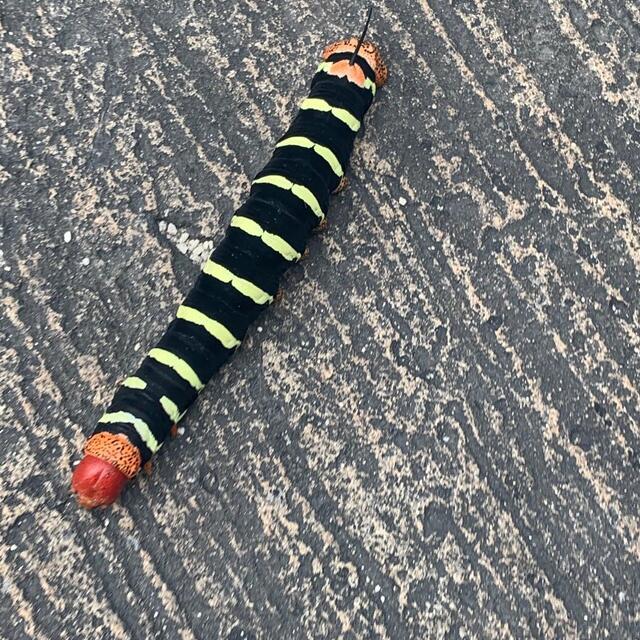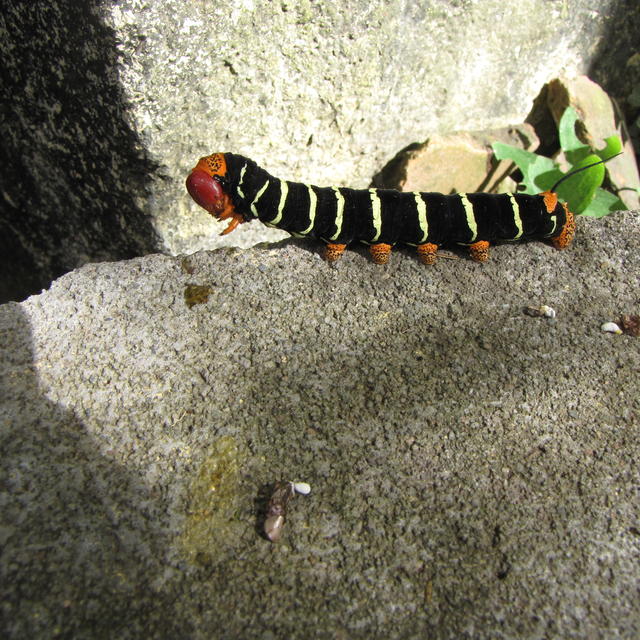Tetrio sphinx
Pseudosphinx tetrio (Linnaeus, 1771)
Family: Sphingidae
Subfamily: Macroglossinae
Identification: Forewing upperside is dark brown with a dark spot at the base of the costa and blurry gray and white markings. Hindwing upperside is dark brown with white along the inner margin and the lower half of the outer margin.
Wing Span: 5 - 5 1/2 inches (12.7 - 14 cm).
Life History: Females lay eggs in clusters on leaves of the host tree.
Flight: . Several flights from March-September in Florida.
Caterpillar Hosts: Frangipani (Plumeria rubra) and other Plumeria species, and Allamanda species; all in the dogbane family (Apocynaceae).
Adult Food: Nectar from flowers including rosy periwinkle (Vinca rosea).
Habitat: Tropical and subtropical lowlands.
Range: Southern Brazil north through Central America, Mexico, and the West Indies to south Florida, southern Mississippi, Texas, and southern Arizona. Has strayed to Nebraska and Pennsylvania.
Conservation: Not usually required.
NCGR: G5 - Demonstrably secure globally, though it may be quite rare in parts of its range, especially at the periphery.
Management Needs: Tetrio sphinx caterpillars can defoliate a frangipani tree in a few days.
Please donate!
We depend on donations to keep Butterflies and Moths of North America freely available. We want to express our gratitude to all who showed their support by making a contribution this year. You can donate to support this project at any time.
Advertise with us!
Do you have a product or service that you think would interest BAMONA users? If you would like to advertise on this website, contact us by email, or use the contact form and select the "Advertising" category.
Verified Sightings
Displaying 1 - 24 of 69 verified sightings

Observation date: Feb 22, 2021
Submitted by: David Hilmy
Region: Stann Creek District, Belize
Verified by: curtis.lehman
Verified date: Dec 09, 2023

Observation date: Sep 24, 2021
Submitted by: David Hilmy
Region: Stann Creek District, Belize
Verified by: curtis.lehman
Verified date: Dec 09, 2023

Observation date: Sep 25, 2021
Submitted by: David Hilmy
Region: Stann Creek District, Belize
Verified by: curtis.lehman
Verified date: Dec 09, 2023

Observation date: Jun 24, 2017
Submitted by: hasfitz5
Region: Costa Rica
Verified by: Paul Prappas
Verified date: Feb 05, 2023

Observation date: Feb 12, 2018
Submitted by: GayleP
Region: The Bahamas
Verified by: curtis.lehman
Verified date: Jan 29, 2023

Observation date: Oct 31, 2015
Submitted by: demaaijer
Region: Bonaire
Verified by: jwileyrains
Verified date: Jan 28, 2023

Observation date: Nov 12, 2019
Submitted by: DrewW
Region: Jamaica
Verified by: curtis.lehman
Verified date: Jan 28, 2023

Observation date: Nov 12, 2019
Submitted by: DrewW
Region: Jamaica
Verified by: curtis.lehman
Verified date: Jan 28, 2023

Observation date: Mar 22, 2019
Submitted by: regina rochefort
Region: Barbados
Verified by: curtis.lehman
Verified date: Jan 28, 2023

Observation date: Apr 20, 2019
Submitted by: jose88
Region: Cayo District, Belize
Verified by: curtis.lehman
Verified date: Jan 28, 2023

Observation date: Nov 12, 2019
Submitted by: DrewW
Region: Jamaica
Verified by: curtis.lehman
Verified date: Jan 28, 2023

Observation date: May 22, 2019
Submitted by: Marc Vlamynck
Region: Jamaica
Verified by: curtis.lehman
Verified date: Jan 27, 2023

Observation date: Sep 28, 2021
Submitted by: Auriel
Region: Puerto Rico
Verified by: curtis.lehman
Verified date: Jan 27, 2023

Observation date: Jan 01, 2016
Submitted by: Selinaoneal
Region: Puerto Rico
Verified by: curtis.lehman
Verified date: Jan 27, 2023

Observation date: Nov 13, 2015
Submitted by: Tim Norriss
Region: Cuba
Verified by: jwileyrains
Verified date: Jan 23, 2023

Observation date: Jun 15, 2016
Submitted by: Tim Norriss
Region: Holguin, Cuba
Verified by: jwileyrains
Verified date: Jan 23, 2023

Observation date: Oct 21, 2022
Submitted by: Paul Prappas
Region: Panama
Verified by: Paul Prappas
Verified date: Nov 08, 2022

Observation date: Nov 10, 2016
Submitted by: LLJohnson
Region: Dominican Republic
Verified by: jwileyrains
Verified date: Oct 05, 2022

Observation date: Nov 25, 2016
Submitted by: LLJohnson
Region: Dominican Republic
Verified by: jwileyrains
Verified date: Oct 01, 2022

Observation date: Oct 24, 2019
Submitted by: Lawrence7
Region: Morelos, Mexico
Verified by: jwileyrains
Verified date: Sep 12, 2022

Observation date: Nov 12, 2013
Submitted by: jpmorgan
Region: Morelos, Mexico
Verified by: jwileyrains
Verified date: Sep 10, 2022

Observation date: Feb 11, 2020
Submitted by: wingsandmore1979
Region: Costa Rica
Verified by: jwileyrains
Verified date: Sep 10, 2022

Observation date: Aug 01, 2022
Submitted by: ChrisMac
Region: St. Lucie County, Florida, United States
Verified by: curtis.lehman
Verified date: Aug 17, 2022

Observation date: May 19, 1994
Submitted by: Allen B
Region:
Verified by: Allen B
Verified date: Feb 24, 2022
- 1 of 3
- next ›






